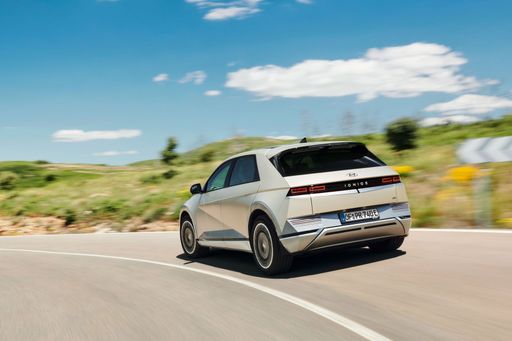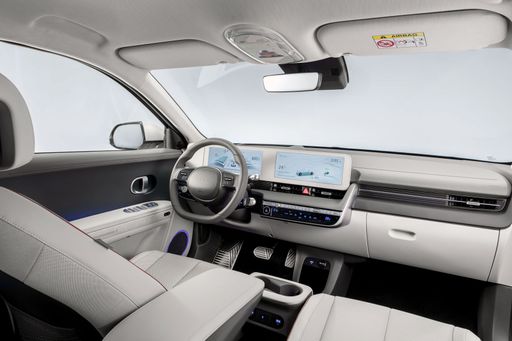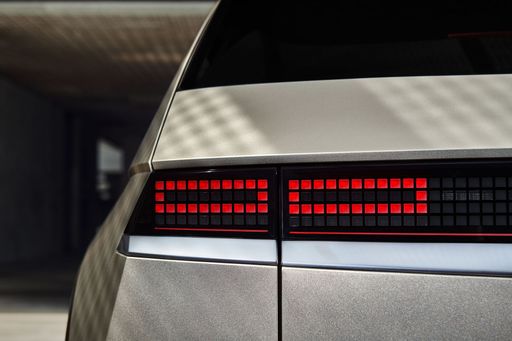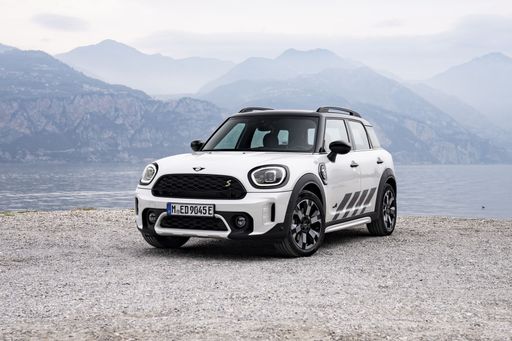Hyundai IONIQ 5 vs MINI Countryman - Differences and prices compared
Costs and Efficiency:
Looking at overall running costs, both models reveal some interesting differences in everyday economy.
MINI Countryman has a clearly perceptible advantage in terms of price – it starts at 31500 £, while the Hyundai IONIQ 5 costs 38500 £. That’s a price difference of around 6943 £.
In terms of energy consumption, the advantage goes to the Hyundai IONIQ 5: with 15.60 kWh per 100 km, it’s hardly perceptible more efficient than the MINI Countryman with 15.70 kWh. That’s a difference of about 0.10 kWh.
As for range, the Hyundai IONIQ 5 performs a bit better – achieving up to 570 km, about 108 km more than the MINI Countryman.
Engine and Performance:
Power, torque and acceleration say a lot about how a car feels on the road. This is where you see which model delivers more driving dynamics.
When it comes to engine power, the Hyundai IONIQ 5 has a significantly edge – offering 650 HP compared to 313 HP. That’s roughly 337 HP more horsepower.
In acceleration from 0 to 100 km/h, the Hyundai IONIQ 5 is significantly quicker – completing the sprint in 3.50 s, while the MINI Countryman takes 5.40 s. That’s about 1.90 s faster.
In terms of top speed, the Hyundai IONIQ 5 performs hardly perceptible better – reaching 260 km/h, while the MINI Countryman tops out at 250 km/h. The difference is around 10 km/h.
There’s also a difference in torque: Hyundai IONIQ 5 pulls distinct stronger with 770 Nm compared to 494 Nm. That’s about 276 Nm difference.
Space and Everyday Use:
Beyond pure performance, interior space and usability matter most in daily life. This is where you see which car is more practical and versatile.
Seats: offers more seating capacity – vs .
In curb weight, MINI Countryman is noticeable lighter – 1620 kg compared to 1955 kg. The difference is around 335 kg.
In terms of boot space, the Hyundai IONIQ 5 offers slight more room – 520 L compared to 505 L. That’s a difference of about 15 L.
In maximum load capacity, the Hyundai IONIQ 5 performs minimal better – up to 1580 L, which is about 50 L more than the MINI Countryman.
When it comes to payload, Hyundai IONIQ 5 hardly perceptible takes the win – 530 kg compared to 500 kg. That’s a difference of about 30 kg.
Who wins the race?
The Hyundai IONIQ 5 proves to be is largely superior and therefore becomes our DriveDuel Champion!
Hyundai IONIQ 5 is the better all-rounder in this comparison.
 @ Hyundai Motor Company
@ Hyundai Motor Company
Hyundai IONIQ 5
Costs and Consumption
View detailed analysis
Engine and Performance
View detailed analysis
Dimensions and Body
View detailed analysis
Hyundai IONIQ 5
The Hyundai IONIQ 5 looks like a spaceship that moved into suburbia, pairing bold retro‑futuristic styling with a roomy, cleverly laid-out cabin that makes long trips surprisingly comfortable. Its electric character delivers instant, silky acceleration and low running costs, making it a smart, slightly cheeky pick for buyers who want tech, practicality and personality without the drama.
details @ Hyundai Motor Company
@ Hyundai Motor Company
 @ Hyundai Motor Company
@ Hyundai Motor Company
 @ Hyundai Motor Company
@ Hyundai Motor Company
 @ Hyundai Motor Company
@ Hyundai Motor Company
 @ Hyundai Motor Company
@ Hyundai Motor Company
MINI Countryman
The MINI Countryman turns the cheeky charm of a classic MINI into a proper all-rounder, blending playful styling with surprisingly usable space for everyday life. It still grins at city lights but will happily tackle muddy lanes, perfect for buyers who want character without sacrificing practicality.
details @ MINI / BMW Group Press
@ MINI / BMW Group Press
 @ MINI / BMW Group Press
@ MINI / BMW Group Press
 @ MINI / BMW Group Press
@ MINI / BMW Group Press
 @ MINI / BMW Group Press
@ MINI / BMW Group Press
 @ Hyundai Motor Company
@ Hyundai Motor Company
|
 @ MINI / BMW Group Press
@ MINI / BMW Group Press
|
|
|
|
Costs and Consumption |
|
|---|---|
|
Price
38500 - 64200 £
|
Price
31500 - 45300 £
|
|
Consumption L/100km
-
|
Consumption L/100km
4.6 - 7.8 L
|
|
Consumption kWh/100km
15.6 - 21.2 kWh
|
Consumption kWh/100km
15.7 - 16.8 kWh
|
|
Electric Range
440 - 570 km
|
Electric Range
432 - 462 km
|
|
Battery Capacity
63 - 84 kWh
|
Battery Capacity
64.60 kWh
|
|
co2
0 g/km
|
co2
0 - 177 g/km
|
|
Fuel tank capacity
-
|
Fuel tank capacity
45 - 54 L
|
Dimensions and Body |
|
|---|---|
|
Body Type
SUV
|
Body Type
SUV
|
|
Seats
5
|
Seats
5
|
|
Doors
5
|
Doors
5
|
|
Curb weight
1955 - 2275 kg
|
Curb weight
1620 - 2075 kg
|
|
Trunk capacity
480 - 520 L
|
Trunk capacity
450 - 505 L
|
|
Length
4655 - 4715 mm
|
Length
4444 - 4447 mm
|
|
Width
1890 - 1940 mm
|
Width
1843 mm
|
|
Height
1585 - 1605 mm
|
Height
1635 - 1661 mm
|
|
Max trunk capacity
1540 - 1580 L
|
Max trunk capacity
1450 - 1530 L
|
|
Payload
385 - 530 kg
|
Payload
460 - 500 kg
|
Engine and Performance |
|
|---|---|
|
Engine Type
Electric
|
Engine Type
Petrol MHEV, Diesel MHEV, Electric, Petrol
|
|
Transmission
Automatic
|
Transmission
Automatic
|
|
Transmission Detail
Reduction Gearbox
|
Transmission Detail
Dual-Clutch Automatic, Automatic Gearbox, Reduction Gearbox
|
|
Drive Type
Rear-Wheel Drive, All-Wheel Drive
|
Drive Type
Front-Wheel Drive, All-Wheel Drive
|
|
Power HP
170 - 650 HP
|
Power HP
163 - 313 HP
|
|
Acceleration 0-100km/h
3.5 - 8.5 s
|
Acceleration 0-100km/h
5.4 - 8.6 s
|
|
Max Speed
185 - 260 km/h
|
Max Speed
170 - 250 km/h
|
|
Torque
350 - 770 Nm
|
Torque
250 - 494 Nm
|
|
Number of Cylinders
-
|
Number of Cylinders
3 - 4
|
|
Power kW
125 - 478 kW
|
Power kW
120 - 230 kW
|
|
Engine capacity
-
|
Engine capacity
1499 - 1998 cm3
|
General |
|
|---|---|
|
Model Year
2024 - 2025
|
Model Year
2024
|
|
CO2 Efficiency Class
A
|
CO2 Efficiency Class
D, E, A, G
|
|
Brand
Hyundai
|
Brand
MINI
|
What drive types are available for the Hyundai IONIQ 5?
The Hyundai IONIQ 5 is available as Rear-Wheel Drive or All-Wheel Drive.
The prices and data displayed are estimates based on German list prices and may vary by country. This information is not legally binding.
